-- Charles Baudelaire, Artificial ParadiseThe vices of man, as full of horror as one might suppose them to be, contain the proof (if in nothing else but their infinitely expandable nature) of his taste for the infinite; only, it is a taste that often takes a wrong turn.

In Ezra Pound's famous (or infamous) "Canto XLV," the poet explains the many ways that usura distorts and stultifies a healthy and vibrant human culture. Towards the end of the Canto the analysis deepens -- it is human fertility itself that is threatened by an economy centred around the practice of charging exorbitant interest. People simply cannot afford to have children. Human sexuality grows further and further away from the procreative and fertile.
Usura slayeth the child in the womb
It stayeth the young man’s courting
It hath brought palsey to bed, lyeth
between the young bride and her bridegroom
CONTRA NATURAM
They have brought whores for Eleusis
Corpses are set to banquet
at behest of usura.
The life instinct becomes a death instinct. Our very desires become twisted. Whores have been brought to Eleusis. What does this mean? It is the inner core of a great mystery. The Eleusinian Mysteries were essentially fertility rites. Sacred sexuality, the hieros gamos, was involved but the focus was on furthering life not avoiding death, on harvest and not on monetary transactions. In short, the mysteries involved free love in every sense of the term.
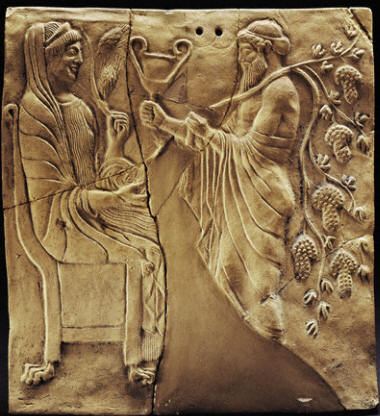
The Lust For Secret History
In The Birth of Modernism: Ezra Pound, T.S. Eliot, W.B. Yeats, and the Occult (1993), critic Leon Surette writes that The Cantos trace in epic fashion the historical interplay of two opposing forces -- one which frees and flows and the other which attempts to block, divert and capture this flow:
The Cantos explain historical event through its exposure of a malignancy blocking the creative forces that are also identified and celebrated in the poem. Pound calls the malignancy "Usura." The creative forces are called "amor" and "Eleusis."
Pound did not view these two as being merely abstract forces. Instead, he saw each as being conscious traditions involving real individuals, groups and institutions throughout history. They were, in fact, in his system of thought, conspiracies.
I've discussed usura at great length in my last post. Unlike present-day conspiracy theorists, however, Pound did not think that the international banking conspiracy, and whatever malign forces lay behind it, was absolute and omnipotent. It is obviously extremely powerful, with the ability to shape history like a sculptor shapes clay, but it is more than matched by what Pound at various times calls "the conspiracy of intelligence," "amor," "the mysterium," "the celestial tradition," and most often, "Eleusis."
In a collection of essays from 1952, A Visiting Card , Pound lays out this dichotomy very clearly and explains exactly the role of the two conspiracies:
We find two forces in history: one that divides, shatters, and kills, and one that contemplates the unity of the mystery...
There is the force that falsifies, the force that destroys every clearly delineated symbol, dragging man into a maze of abstract arguments, destroying not one but every religion.
But the images of the gods, or Byzantine mosaics, move the soul to contemplation and preserve the tradition of the undivided light.
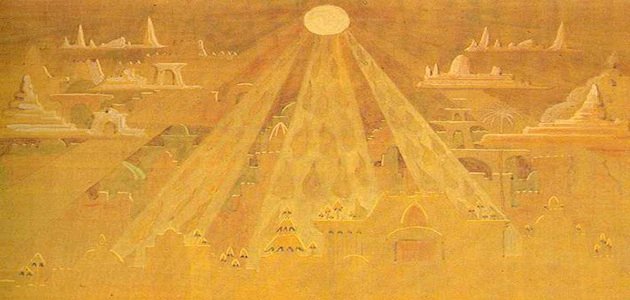
One tradition divides, falsifies and enters one into useless and confusing abstractions. The other, which Pound identifies with, is dedicated to the contemplation of the "undivided light." In an earlier prose work,Guide To Kulchur, Pound characterizes both as "mystic states" which, while having entirely opposite aims and means, are equally concerned with the spiritual.
Two mystic states can be dissociated: the ecstatic-beneficent-and-benevolent, contemplation of the divine love, the divine splendour with goodwill toward others.
And the bestial, namely the fanatical, the man on fire with God and anxious to stick his snotty nose into other men's business or reprove his neighbour for having a set of tropisms different from that of the fanatic's, or for having the courage to live more greatly and openly.
The second set of mystic states is manifest in scarcity economists, in repressors etc.
The first state is a dynamism. It has, time and again, driven men to great living, it has given them courage to go on for decades in the face of public stupidity. It is paradisical and a reward in itself seeking naught further... perhaps because a feeling of certitude inheres in the state of feeling itself. The glory of life exists without further proof for this mystic.
Thus, while usura is obsessed with moralistic legalism, strict adherence to the scriptures, asceticism and imposed scarcity in worldly affairs, suppression of sexuality and the physical, priestly mediation between men and God, and redemption to come, Eleusis represents a radically different mystical ideal.

It proclaims that Paradise is here, right now, and the purpose of life is to creatively celebrate this fact. It is dynamic, open, passionate, compassionate and ecstatic. It takes joy in natural processes and natural beauty. It rejects sin, debt and enslavement of any kind. Life is abundance and the goal is to behold and worship the overflowing abundance of life in this world, in this body.
Plus
Pound explicitly and literally connected this latter movement with the original Mysteries at Eleusis. He believed that there was an unbroken tradition from the ancient mysteries through neo-Platonism, the Gnostics, certain Christian mystics, and in full blossom during the troubadour movement in Provence and Northern Italy during the 12th Century. Pound wrote in 1930:
I believe that a light from Eleusis persisted throughout the middle ages and set beauty in the song of Provence and of Italy.

Pound's favourable association with Eleusis is all the more surprising when we read Joe Atwill and Jan Irvin. According to these authors, Eleusis is the ancient prototype of the rot that led to the ultimate psy-op of the 1960s counterculture. Wasn't, after all, The Road to Eleusis: Unveiling the Secret of the Mysteries (1978) a book co-authored by arch-conspirators R. Gordon Wasson and Albert Hofmann, among others? The Eleusinian Mysteries were the original mind control operation. Atwill and Irvin know this and they are revealing it to us now:
How the elite of ancient Athens controlled the masses was through drug mystery initiations at Eleusis that they managed to keep secret for 2000 years during their reign, and the secret agenda of how the mysteries were actually used for control hasn't been revealed for all to see until now – nearly 4000 years since the mysteries at Eleusis began.
Pound would beg to differ. He would agree, of course, that the Mysteries were at one point corrupted. This is the meaning of his "they have brought whores for Eleusis" line, but he would adamantly disagree that the purpose of the Mysteries was for social control, and he would argue that the pure light from Eleusis can be traced throughout history.
How, Atwill and Irvin and others might protest, could Pound have gotten this so wrong? Pound, the mentor of Eustace Mullins and the exposer of usura, how could he also be a celebrant of the Eleusinian Mysteries?
Pound would reverse these questions. Obviously these people, who are genuinely concerned with tracking the machinations of usury throughout history, are missing the big picture. There is much beauty in the creations of humanity, and this beauty arrives to us through a "conspiracy of intelligence" that has its roots in the ancient and archaic fertility rites. To see only one absolute and malign conspiracy is to give up the battle from the outset. We also are the heirs of great vision and wisdom.
Pound discusses these sorts of "shallow minds" and their desire for all-encompassing conspiracy theories:
Shallow minds have been in a measure right in their lust for "secret history". I mean they have been dead right to want it, but shallow in their conception of what it was. Secret history is at least twofold. One part consists in the secret corruptions, the personal lusts, avarices etc. that scoundrels keep hidden, another part is the "plus", the constructive urges, a secretum because it passes unnoticed or because no human effort can force it on public attention.
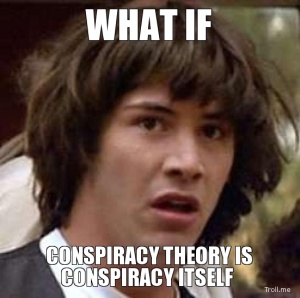
Without the realization that "secret history is at least twofold," without equal acknowledgement of the "plus," of Eleusis, our analysis lacks all profundity. However much we expose the Agenda we will be lost if we cannot also connect with those forces and agencies that tirelessly work for our liberation.
But beyond this, those who seek to convince us that there is no other conspiracy apart from that desiring total control, those who natter on that all liberation movements of the past, all inspiring works of art and literature, all personal visionary experiences are entirely facets of the nefarious design for our complete enslavement, who are these people anyway? Which of the conspiracies that Pound identifies do they actually, wittingly or not, serve?
An Empire Of Discord
Leon Surette traces Pound's study of "secret history" back to a variety of sources. Throughout the modern period certain individuals have been obsessed with mapping out the conspiracies of history. One of the first, and a direct though opposed precursor of Pound, was the French Jesuit priest, Abbé Augustin Barruel. Barruel in 1797 wrote what was probably the first Illuminati conspiracy theory in his monumental Memoirs Illustrating the History of Jacobinism.

Barruel's purpose in writing the Memoirs was to discredit the French Revolution. His thesis was that the Revolution was planned and fomented by the Bavarian Illuminati, which was itself the most recent manifestation of an ancient Manichean conspiracy that was sworn to destroy Christendom and overthrow the monarchies of Europe. Barruel believed that the ultimate origin of the conspiracy, openly revealing itself in the Cathar movement of Provence, was in the teaching of the Manichean prophet himself, Manes:
Attending only to the most striking similarities, we have seen the Occult founded on the Bema of the Manichæans. It was Manes whom they were to avenge on all Kings, on Kings who had condemned him to be flayed alive and who, according to his doctrines, had only been instituted by the evil spirit; and the word to be recovered was that doctrine itself, to be established on the ruins of Christianity.
The Templars, taught by the adepts dispersed throughout Egypt and Palestine, substituted, at their dissolution, their Grand Master Molay for Manes, as the object of their vengeance; and the spirit of the mysteries and the allegories remained the same. It is always Kings and Christianity that are to be destroyed, Empires and the Altar, to be overturned, in order to re-establish the Liberty and Equality of human nature.
It is fascinating not only that Barruel viewed the Knights Templar as being a key link in the conspiracy, with de Molay as a new Manes, but that the conspiracy that Barruel was against was essentially democratic in nature. Barruel was an enemy of the conspiracy to liberate humanity. Surette remarks:
Barruel's attribution of the revolution and all earlier upheavals in Europe to a single heretical doctrine is entirely implausible, but its status as the grandfather of modern conspiracy theories is unchallengeable.

Barruel took some of his insights about the Manichean conspiracy from the theologian François-André-Adrien Pluquet's Dictionary of Heresies (1762). In his Dictionary, Pluquet explains the beliefs of the Manicheans:
They supposed a God supreme, but they attributed the government of the world to another principle, the empire of which does not extend further than this world, and will finish with the world. It was in the earth's centre that those formidable powers, the gods of evil, resided...
The abode of this evil principle was filled with spirits, who were essentially in a state of movement, because it is only happiness which is calm, and the movements of these troubled spirits, like the restlessness of unhappy mortals, had neither design nor order — discord reigned throughout their empire. The evil principle is the cause of all the misfortunes of the universe; it ruined mankind, and gained possession of the empire of this world.
According to Barruel, because the Manicheans were convinced that all governments and authorities of this world were in league with the "evil principle," to advocate the overthrow of these authorities was fully justified. Baruel thought the Manicheans were entirely wrong in this conviction. Instead, following Catholic doctrine, Barruel argued that however corrupt a king might be he sits on his throne by the will of God. The first rebel was Lucifer and to seek revolution is to attempt to dismantle the order of God.
Despite the obvious extremism of his ideas Barruel's influence is immense. All of the Illuminati conspiracy theories that exist today, including that of Robert Welch and the John Birch Society, ultimately derive from Barruel. Understandably, though, some that read Barruel's information did not agree with his conclusions.
One such thinker, which Surette highlights among a handful of others, is Gabriele Rossetti. Rossetti was a Italian Freemason and a member of the revolutionary Carbonari. Following the Revolution of 1820 Rossetti, blacklisted for writing poems in support of the failed revolt, fled to England.

It was after he left Italy that Rossetti published the two volumes of Disquisitions on the Antipapal Spirit (1834), which presented a version of "secret history" that both expanded and completely inverted Barruel's own theories. Rossetti's ideas, both directly and indirectly, would have an enormous impact on Pound.
Rossetti agreed with Barruel that there existed a centuries-old conspiracy against the Roman hierarchy and its allied monarchs, but unlike Barruel he was very much in favour of this conspiracy. Rossetti, following Barruel, believed that the roots of this conspiracy were Manichean but, and this is where his originality lies, he also thought that the members of this revolutionary conspiracy communicated to each other in code within, among other writings, the greatest works of European art and literature. It is worth quoting Rossetti at length:
If we explore the secret recesses of ancient literature, what else shall we find there but one vast conspiracy of the learned against the Roman hierarchy? What else shall we see but cunning struggling against cruelty, hatred dressed in the garb of friendship, and hypocrisy turning the weapons of force against itself?
Works of every size, in every language, written in verse and in prose, on literary and philosophical subjects of all kinds, with every variety of outward meaning, and with but one inward design, were published by this secret school; and often those which appear the most simple, are the most mysterious.
The greatest number of those literary productions, which we have hitherto been in the habit of considering in the light of amusing trifles, or amatory rhymes, or as wild visions of the romantic, or heavy treatises by the dull scholar, are in reality works which enclose recondite doctrines, and secret rites, an inheritance bequeathed by remote ages; and what may to many appear mere fantastic fables, are a series of historical facts expressed in ciphers, which preserve the remembrance of the secret actions of our fathers.
Rossetti was particularly obsessed by the evidence of this "secret school" in the poetry of Dante, although he was also able to find the same "inward design" being "expressed in ciphers" in the poetry of Calvacanti, Petrarch and the troubadours. All of these and more, the most gifted minds of history, were enlisted by the shadowy conspiracy for its goal of total revolution.
The most learned men, and authors of various ages and countries, were pupils of this mysterious school, and never losing sight of their one grand object, they were constantly on the alert to bring persons of talent and genius to their way of thinking, and to render them co-operators in their bold projects....
The ungovernable thirst for freedom, and the effervescence of political opinions, which have for so long agitated the hearts and minds of men throughout Europe, are but the tardy effects of the slow, but unceasing labours of this ancient school, which worked to free mankind from the tyranny of priesthood, as well as from monarchical despotism.
Surette points out that Pound likely did not read Rossetti directly until quite late in his career. At this point also he was in correspondence with Rossetti's granddaughter. He was, however, deeply familiar with the work of others who were themselves heavily influenced by Rossetti. The French occultist, Joséphin Péladan, and the Italian scholar, Luigi Valli, were two such writers.
Valli, in particular, was close in his ideas to Rossetti. And while Pound openly criticizes Valli's "unconvincing" theories this is not to be taken as a general critique of "secret history."
Pound scholar, Demetres P. Tryphonopoulos explains this point in The Celestial Tradition: A Study of Ezra Pound's Cantos:
Pound objects not to the presence of a message [in Dante's poetry] but to its nature: For Valli the message is secret and political; for Pound it is esoteric.
Another key way that Pound's own version of the "secret history" differed from Barruel or Rossetti or Valli was that he did not think its origins were Manichean. Pound disagreed with the Manichean doctrine that the body, sexuality and matter in general were essentially evil. He also uniquely denied that the Albigensians of Provence and earlier Gnostic sects were either Manichean or dualist. Instead, Pound, based in part on the scholarship of the Theosophist, G.R.S. Mead, viewed the "conspiracy of intelligence" as originating with the Mysteries of Eleusis.

As the poet writes in Guide To Kulchur:
Prose is not education but the outer courts of the same. Beyond its doors are the mysteries. Eleusis. Things not be spoken of save in secret.
The mysteries self-defended, the mysteries that cannot be revealed. Fools can only profane them. The dull can neither penetrate the secretum nor divulge it to others.
Becoming the Great Accursed
Eleusis as a conspiracy, then, is at once revolutionary and esoteric. It is a conspiracy of art and life itself. The "light from Eleusis" which "set beauty in the song of Provence and of Italy," both in the troubadour movement and in the Cathars or Albigensians, later shone on the entire history of true poetry and art from the twelfth century onwards. Pound, in an essay of the same name, call this "The Tradition":
The tradition is a beauty which we preserve and not a set of fetters to bind us. This tradition did not begin in A.D. 1870, nor in 1776, nor in 1632, nor in 1564. It did not begin even with Chaucer.
The two great lyric traditions which most concern us are that of the Melic Poets and that of Provence. From the first arose practically all the poetry of the “ancient world,” from the second practically all that of the modern.

The nine Melic Poets would have all been very familiar, if not initiates themselves, with the Eleusinian Mysteries. The troubadours and Cathars of Provence, by a traceable lineage, are their direct spiritual descendents according to Pound. But, as the poet explains, the tradition did not end in Provence. Tryphonopoulos notes that the names of those who Pound includes within the "celestial tradition" have nearly all been influenced by Hemeticism or Gnosticism. The three really make up one single tradition:
Pound's list of philosophical heroes and villains in the Guide to Kulchur reveals his own commitment to this gnostic or hermetic tradition.... Pound includes Pythagoras, Plato, Plotinus, Iamblichus, Porphyry, Psellus, Plethon, the Corpus Hermeticum, Scotus Erigena, Grosseteste, the Masons, Ficino, Pico della Mirandola, Heydon, Blavatsky, Mead, and Yeats. To these names others can be added from the pages of Guide to Kulchur: Manes, Albertus Magnus, Dante, Swedenborg, Orage, Upward, H.D., Balzac, Brancusi, Cocteau, and Gurdjieff. The tradition that Pound is tracing is the Hermetic or Gnostic one. He calls it "Eleusis."
Eleusis, then, is a much bigger movement than the ancient mysteries. It is a living poetic and visionary tradition that still exists, even if its "members" are unaware of being a part of it, at the present time. In the most part it does not consist of secret teachings or techniques that are passed down from initiated masters to their disciples. There is a sort of transmission, a code is sent and received, but nothing is formalized.

Of all those listed above only "the Masons" are an organization and not an individual. And Pound certainly would not want to include all of Freemasonry within the tradition. Freemasonry as an institution has very evidently been compromised by usura for quite a long time. Pound would have been interested in its original manifestation yet only with the truly creative individuals within it.
The list above, however, would set alarms ringing in the heads of Illuminati conspiracy theorists. Aren't these just the names of those who are the key historic players in the grand conspiracy to establish an occult New World Order? Isn't Pound, by exposing usura, also against this same conspiracy? Obviously not.
Pound went deep enough in his research to figure out, again, that "secret history is at least twofold." Usura is fully concerned with material gain and political and social control. Eleusis is essentially driven by the desire to create and contemplate the beautiful. The two, despite how muddled, intertwined and spaghetti-ized they've become, are at heart irreconcilable.
No matter how many times usura uses creative individuals of Eleusis unwittingly, perhaps like Pound himself, to advance its agenda, no matter how many false prophets and sham artists dishonestly present themselves in the guise of Eleusis, and no matter how many times the utopian projects of the Eleusians are co-opted and misdirected horribly by the agents of usura, the pure spirit of Eleusis remains.

There is no organization of Eleusis, no central office, no bureaucracy or member cards. Various "members" of this conspiracy have spawned all of these things, but usually without planning to do so and often to their great regret. It is these organizations that are swallowed up by usura. Individuals of Eleusis do not rise in the ranks of a cult, a sect or a corporation to achieve their visions. They are somehow "called" to seek these vision by themselves. So wrote the poet Arthur Rimbaud in 1871:
I say that one must be a seer, make oneself a seer.
The poet makes himself a seer by a long, prodigious, and rational disordering of all the senses. Every form of love, of suffering, of madness; he searches himself, he consumes all the poisons in him, and keeps only their quintessences. This is an unspeakable torture during which he needs all his faith and superhuman strength, and during which he becomes the great patient, the great criminal, the great accursed - the great learned one! - among men.
For he arrives at the unknown! Because he has cultivated his own soul - which was rich to begin with - more than any other man! He reaches the unknown, and even if, crazed, he ends up by losing the understanding of his visions, at least he has seen them! Let him die charging through those unutterable, unnameable things: other horrible workers will come; they will begin from the horizons where he has succumbed!
The "other horrible workers," the future crazed poets and lovers who come to the very horizon of the unknown where the prior poet either achieved transcendence or succumbed to stark-raving madness, will continue on. Their work will inspire new work. Visions will build upon visions. This is how the tradition is transmitted within Eleusis.
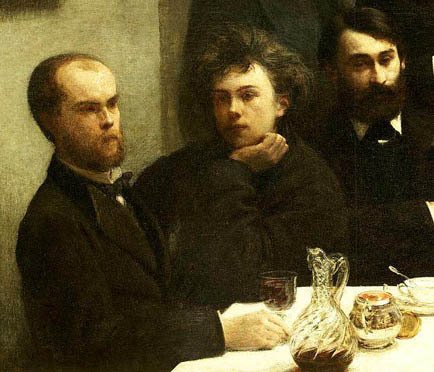
Rimbaud was a French symbolist poet who wrote everything that he is famous for before the age of 20. He was definitely an unofficial member of the "celestial tradition." Rimbaud's letter clearly shows that, almost a century before the nineteen-sixties, psychedelic exploration by artists and "seers" was already very much underway. Rimbaud used absinthe, opium and hashish, among other substances and methods, to rationally disorder his senses. He wasn't the first.
Armies of Romance
Back in 1821, Thomas de Quincey published The Confessions of an English Opium-Eater. Along with describing the pains of his addiction, de Quincey also related how the visions of opium could be used for creative inspiration. De Quincey wrote of how his friend, the Romantic poet Samuel Taylor Coleridge, was able to use the drug in this way. It has been long suspected that Coleridge, who started taking opium in the 1790s, used his drug-induced reveries as the basis for his most famous poem, "Kubla Khan."

However the drug affected his creativity, it was Coleridge who gave us the best definition of the imagination and it is the imagination which is at the root of Eleusis:
The primary IMAGINATION I hold to be the living Power and prime Agent of all human Perception, and as a repetition in the finite mind of the eternal act of creation in the infinite I AM.
Drugs were and are certainly employed to tap into the imagination. De Quincey's book became hugely influential to the Romantic movement and in France it helped to inspire the poet Charles Baudelaire's Artificial Paradises (1860). The book describes, as in de Quincey, the poet's experiences with opium and hashish as means to experience a "taste for the infinite." Rimbaud, who considered Baudelaire the "king of poets,"obviously gained much from this book.
Baudelaire, himself heavily influenced by the U.S. Romantic author Edgar Allen Poe, was a member in the 1840s of the Club des Hashishins (the Club of the Hashish Eaters). The Hashishins would gather every month for "seances" induced by eating the strong hashish, which had made its way into France in the early 1800s with soldiers returning home from Napoleon's campaign in Egypt.

Along with Baudelaire, the Club contained some of the biggest names in French literature and art -- Alexandre Dumas, Victor Hugo, Gérard de Nerval, Eugène Delacroix and Honoré de Balzac. Balzac, as Surette notes, shows up in Pound's list of "celestial tradition" members. Balzac's friend Victor Hugo, the author of Les Misérables, is important here as, beyond inaugurating France's Romantic movement, he and his artist friends were among the first bohemians.
In the preface to his 1827 historical drama, Cromwell, Hugo characterizes what would become French Romanticism:
Down with theories and systems! Let us tear away the old lath-and-plaster hiding the face of art! There are neither rules nor models; or, rather, no rules but the general laws of Nature!
Hugo and his friends were prepared to fight for these new principles. When French government censors prevented one of his plays from being performed Hugo made sure that this would not happen again with his 1829 play, Hernani. He gathered together a rag-tag "Romantic Army" to defend it from being shut down.
They [the Romantic Army] ensured that there was enough of a crowd upon opening night that the play could not be shut down. They arrived in the most absurd styles, and fashions, most of them exceedingly young, though already accomplished. Upon the premiere night, these proto-bohemians were locked within the auditorium for three hours, and in that time managed to make quite a mess of it, mostly due to the lack of facilities provided for them.

Thus long before Bernays brought Vaslav Nijinsky and the Russian ballet to the U.S. to, according to Atwill and Irvin, "debase" its culture, and even before Nijinsky's notorious production of Stravinsky's "The Rite of Spring" set off riots in Paris in 1913, artistic performances were inspiring passionate and violent reactions. Bernays did not invent this.
The "proto-bohemians" of the Romantic Army were some of the first in a long line of social misfits that includes the beats, the hippies and punk, post-punk and syncnik sub/countercultures.
From the 1820s, at least, the telltale signs of the counterculture have existed -- voluntary poverty, alternative lifestyles, experimentation with mind-altering substances, political radicalism, the fostering of creativity, interest in the occult and other taboo subjects, sexual liberation, and a desire to shock and subvert bourgeois culture.
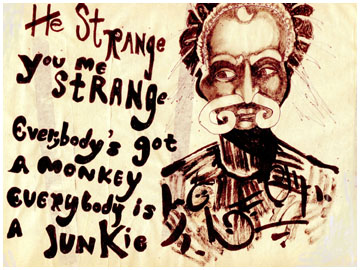
None of these things started in the 1960s, or with Bernays in the 1900s, or even in Germany in the late 19th century. They are perennial. Even the fashion of the 1960s was anticipated by the 19th century bohemians of France and elsewhere.
By the 1830's, the French Bohemian art crowd and the Romantics embraced medieval and oriental clothing styles. With their colorful fabrics, long flowing hair, and wide brimmed hats, the artistic culture did come to resemble Gypsies...
Bohemian style evolved into a cult of the individual, a person whose very appearance became a work of art with carefully planned outfits and accessories. The word bohemian suggested a sense of arcane enlightenment, sexual freedom, and poor personal hygiene.
Bohemian life rejects materialism, private property, and centers on creativity and communal living. Often associated with the use of drugs and alcohol, bohemians ignore social convention, centering their lives on art.
Throughout the 19th century, then, bohemianism could be found in low-rent neighbourhoods of urban centres across Europe, North America and even far-flung places like Japan. It was in these vortices of radical and creative tumult that, here and there, it would be possible to encounter a true initiate of Eleusis.
In France, the bohemian current flowed through Romanticism, the Symbolist movement and the Decadents. The popularity George du Maurier's novel about bohemian life in Paris, Trilby (which directly involved mind-control in its plot!), proved that interest in this counterculture was very much alive in 1894.

A Carpet of Tiny Flowers
It is important to note, however, how international and interconnected this broad movement has always been. The Romantic movement in France led directly to the Symbolists and Decadents, with several overlapping members. These artistic movements also had their counterparts in Britain, the U.S., Germany, Russia and elsewhere. The artists were genuinely international, moving from bohemia to bohemia across many borders, and prolific correspondence maintained intimate connections at a distance.
Surette notes a fascinating coincidence of interconnection regarding Gabriele Rossetti:
It is a curious coincidence that, in April 1826, Rossetti married Frances Polidori, sister of Dr John Polidori. John Polidori was the physician who accompanied Byron on his travels; he was a member of the famous Swiss evenings of 1814 that produced Frankenstein and the Byron/Polidori story, Vampyre, the prototype for Bram Stoker's Dracula. One can hardly fail to recall that Frankenstein and Dracula are important sources for the popular literature of the occult. However, I do not attach any particular significance to the coincidence.
These "famous Swiss evenings" also involved drinking copious amounts of laudanum, seances, and other assaults on the limits of usual perception. They were best depicted in the 1986 movie, Gothic, directed by Ken Russell. The nights were hosted by Lord Byron and were attended by Dr. Polidori, the poet Percy Shelley and his wife Mary.
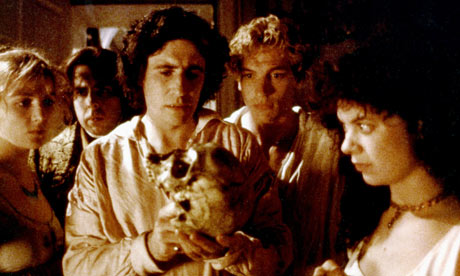
Mary Shelley was the daughter of the anarchist writer, William Godwin, and his wife, the early feminist Mary Wolstonecraft. The couple were also friends with William Blake. Aside from showing how culturally incestuous this all is, it also reveals again that visionary experience involving drugs, feminism, the occult, radical politics and creative boundary dissolution were all in full swing more than a century before the 1960s.
Rossetti was himself the father of four children who were also involved in the arts. His sons, Dante Gabriele and William Michael, were central members of the Pre-Raphaelite Brotherhood. This movement in painting went on to directly affect the French Symbolists and was a major influence on W.B. Yeats's father, John Butler Yeats.
A major hub of the international bohemian network was the weekly salons of the late Symbolist poet, Stéphane Mallarmé, starting in the 1880s. These were Tuesday night gatherings, called Mardites in French, which attracted poets, artists, occultists and bohemians from all across Europe.
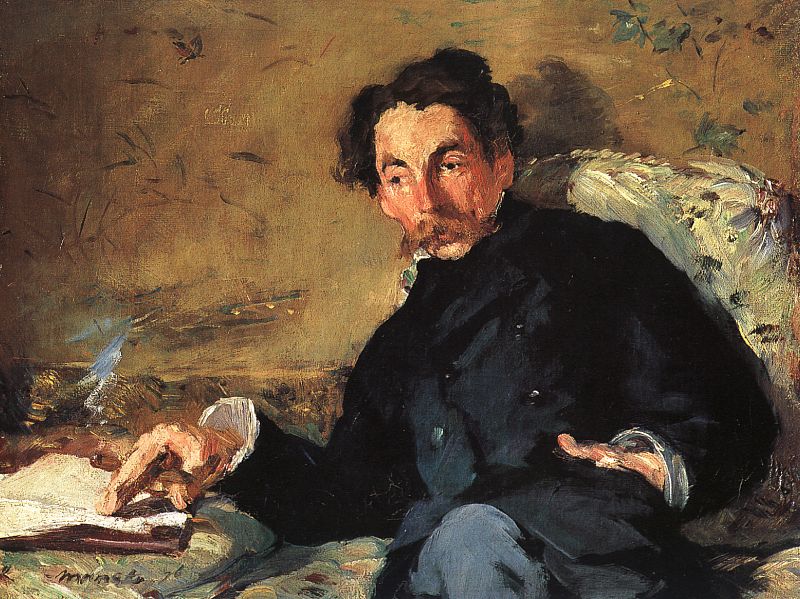
Stephan George, a German Symbolist poet who had his own "circle" in Germany and was also a member of the Munich Cosmic Circle, was one Mardiste who helped to forge connections between the French movements and the various alternative scenes in Germany, later centred around Ascona in Switzerland. W.B. Yeats was also a frequent attendee of the Tuesday night salons.
Mallarmé's salon was a precursor to an even more famous Paris salon of the early 20th century. This was the writer Gertrude Stein's Saturday night salon at her apartment, described as the first modern art museum, at 27 rue de Fleurus. Guests included Pablo Picasso, Henri Matisse, James Joyce, Ernest Hemingway and Ezra Pound. Stein wrote a history of her salon days called The Autobiography of Alice B. Toklas.
Little by little people began to come to the rue de Fleurus to see the Matisses and the Cézannes, Matisse brought people, everybody brought somebody, and they came at any time and it began to be a nuisance, and it was in this way that Saturday evenings began.
Stein's influence was enormous. It was Stein, for example, that suggested that the U.S. writer Paul Bowles go to Tangiers. Bowles went and settled there and his place in Tangiers later became a Mecca for Beat writers like William S. Burroughs and Allen Ginsberg. Tangiers is the "Interzone" of Burroughs' Naked Lunch.
Gertrude Stein's personal history before she moved to Paris from the U.S. is also fascinating. Allen Ginsberg, in his December 1968 article "Remarks on Leary's Politics of Ecstasy" in the Village Voice, lays out a very interesting source for the '60s counterculture involving Gertrude Stein, her time at Harvard University, and her teacher while she was there, William James.
One scholar who transmitted Blake's kabbalah, S. Foster Damon, can remember his sudden vision of tiny flowers carpeting Harvard Yard violet before World War One, an image that lingers over 60 years in mind since his fellow student Virgil Thomson gave him the cactus Peyote to eat. Damon concludes that rare beings like Blake are born with physiologic gift of such vision, continuous or intermittent.
William James, whose pragmatic magic probably called the Peyote God to Harvard in the first place, had included shamanistic chemical visions among the many authentic "Varieties of Religious Experience." His student Gertrude Stein experimented in alteration of consciousness through mindfulness of language, an extremely effective Yoga since mechanical reproduction of language by XX Century had made language the dominant vehicle of civilized consciousness; her companion Alice B. Toklas contributed a cookbook recipe for Hashish Brownies to enlighten those persons over-talkative in drawing rooms unaware that "the medium is the message."
Ginsberg's article provides as good an account on the origins of the sixties as anywhere. He also introduces a new element into the mix. "Bohemians" were not only experimenting with opium, hashish and absinthe. By the end of the 19th century, peyote and mescaline had entered the scene. Long before LSD, there was experimentation with psychedelics proper in the Western counterculture.

Gertrude Stein's Harvard teacher, mentor and friend, William James -- the brother of one of Pound's literary heroes, Henry James -- was an early peyote experimenter. James, as detailed in his famous Varieties of Religious Experience, used many techniques and substances, like ether, to explore different states of consciousness. He tried peyote in 1896:
Concerning the "mescal episode", there are a number of things to say. First, James received the peyote buttons from the Philadelphia neurologist, Silas Weir Mitchell, a close friend. Mitchell had gotten them from the US Government, who had ordered cavalry physicians at outposts in the Southwest to collect them from the Indian tribes who used them in religious ceremonies. Mitchell's task was to find out more about what these substances were. Whatever chemical assay was performed, Mitchell and other physicians also ingested the peyote themselves and reported extraordinary states of consciousness.

The composer, Virgil Thomson, appears to have "turned on" many people to peyote during this time. In addition to introducing it to the Blake scholar, S. Foster Damon, Thomson was a source of peyote for members of the Harvard Poetry Society:
John Joseph Sherry Mangan was born in Lynn, Massachusetts, on June 27, 1904. He entered Harvard in 1921, where he studied classics and became introduced to Wheelwright at meetings of the Harvard Poetry Society. Virgil Thomson introduced peyote to Mangan, who subsequently obtained "mescal caps by mail from New Mexico for the peyote parties in his room in Weld Hall." (Virgil Thomson, An Autobiography, 1966).
Harvard was not the only place having peyote parties at this time. At the salon of Mabel Dodge in New York -- which like the Stein salon in Paris attracted writers, artists and even anarchists like Emma Goldman and Alexander Berkman -- there is a report in 1914 of an incident involving peyote.
Gertrude Stein did not write directly about peyote, but as the favourite student of William James, the good friend of both Virgil Thomson and Mabel Dodge, and the author of the weird modernist classic, Tender Buttons -- speculated to be about peyote, a woman's nipples or both -- it is likely that she had been experienced.

In addition, as Ginsberg points out, one of the recipes in Stein's lover's The Alice B. Toklas Cook Book (1954), actually provided by Brion Gysin the artist, was for hash brownies. Pablo Picasso, Gertrude Stein's best friend, was a notorious imbiber of hashish.
It is very likely that there was a lot more going on at Gertrude Stein's salon before and after World War One than lively conversation about art and literature. If the writing of James Joyce, Ezra Pound and even Hemingway at times appears to be at least partially inspired by psychedelics that is probably because it was. The whole scene at the time was as dedicated as Rimbaud to a "long, prodigious, and rational disordering of all the senses."
W.B. Yeats, a mentor of both Pound and Joyce and the man who first introduced the two younger writers, used both hashish and peyote/mescaline, trying the latter while under the supervision of the controversial doctor, Havelock Ellis, in 1897. Yeats spent three winters with Ezra Pound in rural England during WW1 and it is very likely that the two poets, in addition to pursuing occult studies, also shared a taste for induced visionary experiences.
No Shit, Mind Control
The occult aspect of all this, of Eleusis, is also highly fascinating. Marshall McLuhan, who later became friends with Ezra Pound, was distressed to discover how deep the occult current ran through the work of his favourite modernist writers. In a letter he wrote to Pound in Feb. 1953, McLuhan expressed his shock and dismay:
Last year has been spent in going through rituals of secret societies with fine comb. As I said before I'm in a bloody rage at the discovery that the arts and sciences are in the pockets of these societies. It doesn't make me any happier to know that Joyce, Lewis, Eliot, yourself have used these rituals as a basis for art activity.
This is very revealing. Here is Marshall McLuhan, a man people like Jan Irvin claim to be one of the chief architects of the sixties psy-op, expressing his hatred of the occult conspiracy, which he suggests goes to the root of modernism, to Ezra Pound, a man which most conspiracy theorists argue exposed just such a conspiracy. In contrast, it seems, it was McLuhan who was against such a conspiracy and Pound who was in the thick of it!

The following is what Jan Irvin thinks of McLuhan and Joyce. This was his reaction in a Facebook comment from July 14-15, 2013 to a statement by our compadre, Bill Klaus, on a Red Ice interview:
"What Joyce is trying to do is make people aware of the constructs of language that they are in all the time. I connected a straight line on the edges of this Jig saw puzzle blah blah: James Joyce, Marshall McLuhan, and Stanly Kubrick and the internet are the corner pieces to seeing what the 20th century was really about" ... yeah, no shit, mind control and manipulation from all of the above mentioned... incredible.
But here these clowns are quoting McLuhan, etc... the guy who created the Tune IN Turn On Drop out meme to destroy the masses... this is just sick shit.
And yet Ezra Pound was a friend of both James Joyce and Marshall McLuhan, and McLuhan actually despised this type of conspiracy. McLuhan's perspective was much closer to the Abbé Barruel than to Gabriele Rossetti or Ezra Pound. McLuhan was no fan of Eleusis:
The secret societies, McLuhan claimed, were characterized by a use of ritual and liturgy designed to put adherents directly in touch with occult spiritual forces existing in the timeless patterns. For the societies, those forces and patterns were alone real, not the world of appearances. McLuhan characterized the philosophy behind these societies with varying labels: "gnostic," "hermetic," Buddhist," "Neo-Platonic," and so on. They posed a deadly threat to the Catholic Church, which, along with Aristotle, insisted that the senses did not deceive the mind and that the material world was dependably real.
So here's an uncanny conundrum. Joyce was in the Conspiracy, Pound was in the Conspiracy, but McLuhan was not? What about "Turn On, Tune In, Drop Out"? Was Leary actually working for the Church?

It should be obvious at this point that no movement, no event, no person, can ever be reduced to black and white terms. Complexity, nuance, variation, contradiction, surprise -- these are always in play. How much of the bohemian counterculture, which stretches back to more than a century before the 1960s, was manufactured by TPTB? Will we ever be able to definitively answer this question?
It seems pretty clear, though, that sexual images, wild dancing, music idols, feminism, integration and psychedelics -- all of the bullet points that Atwill and Irvin isolate -- were all happening well before the influence of Bernays and Wasson. It is doubtless that those in power attempted to influence, infiltrate and direct these movements, but this was not in any manner all that was going on. Throughout each was also a stream of potency from Eleusis.
In The Zome
And according to Pound this stream can be traced back to the troubadours and Cathars of Provence. Before the bohemians were the alchemists, the mages of the Renaissance, medieval heresies like the Free Spirit, the Fedeli d'Amore group of poets centred around Dante and Calvacanti, and finally back to the troubadours themselves. In each of these Eleusis is occasionally revealed, but we know that for Pound the tradition is much older. It extends back to the original fertility Mysteries and their even more archaic ancestry.
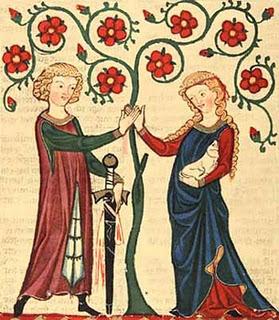
Provence in the 12th century, though, is a turning point. It begins the modern wave of resistance. Here Eleusis almost fully unveiled herself. It was AMOR directly against ROMA, love against the Empire. And neither it nor the Empire ever died. It manifested in the south of France, but that was not the only place to witness the expression of AMOR at this point in history. Joseph Campbell, in his Creative Mythology, explains that this time was a pivotal one for the entire globe:
...Simultaneously with the rise, at the opening of the twelfth century, of this elite tradition of Arabized European poetry, the "cult of the dame," likewise "following the Arab precedent," also suddenly appears. Thus we now have evidence of an unbroken, though variously modified, aristocratic tradition of mystically toned erotic lore, extending from India not only eastward as far as to Lady Murasaki's sentimental Fujiwara court in Kyoto, but also westward into Europe, and even rising to almost simultaneous culmination all the way from Ireland to the Yellow Sea...
The "cult of the dame", the resurgence of the archaic fertility/goddess tradition, swept the whole length of the Eurasian super-continent. Eleusis was on the rise but it emerged in that time with roots, as Pound pointed out, in the Gnostic and Hermetic traditions. And yet even this genealogy is incomplete. It is too tidy and organized. Too "aristocratic." As we saw with the 19th century, the tradition is also Bohemian. And by this I mean Bohemian in the larger and deeper sense. It is Gypsy.
The artists and eccentrics of the early 1800s in France or elsewhere came to be called bohemians because they dwelt in low-rent neighbourhoods near or once occupied by the Gypsies. And in those days people thought the Gypsies came from Bohemia. The excellent documentary on Gypsy music, Latcho Drom, shows us however that the Gypsies, or (ironically) Roma, have their origins not in Egypt as their given name suggests, but in Rajasthan.
The colorful and musical tribes of Rajasthan, though, are not the only people who took to nomadism and marginalized living. In the Himalayas to the north of Rajasthan and extending all the way to the lower mountains and hills of South East Asia are pockets of hearty "hilltribes" who have very intentionally rejected the governments, organized religions, and settled and ordered modes of being that have always been established in the valleys. Certain anthropologists now call this vast area, one of the largest stateless zones left on Earth, "Zomia."

Just as the déclassé artists and nonconformists rejected bourgeois customs and morals in emulation of their gypsy neighbours, and just as the Roma, the original Bohemians, have always existed as a self-marginalized group of tinkers, beggars, soothsayers and musicians that valued festive living over hard work and material accumulation, the hilltribes of Zomia likewise choose freedom and autonomy over the security and comforts of the modern State. Eleusis can be found whenever such values are affirmed.
Pound's mentor, W.B. Yeats, pushes this into an even bigger dimension. Yeats, like Pound, was fascinated by the religious and cultural movements of Provence. In addition to seeing an Arabic and Sufi connection to the troubadours, Yeats thought that these minstrels were directly influenced by the ancient Bardic tradition of the Celts. Many scholars have since agreed with Yeats on this point. But, continues Yeats, even the Bards of Ireland were not so special in this regard.

Every culture is built around a corresponding mythology. The great epic poetry of all lands stems entirely from the myths and folklore of the people.
Folk-lore is at once the Bible, the Thirty-nine Articles, and the Book of Common Prayer, and well-nigh all the great poets have lived by its light. Homer, Aeschylus, Sophocles, Shakespeare, and even Dante, Goethe, and Keats, were little more than folk-lorists with musical tongues. The root-stories of the Greek poets are told to-day at the cabin fires of Donegal; the Slavonian peasants tell their children now, as they did a thousand years before Shakespeare was born, of the spirit prisoned in the cloven pine.
This is a profound thought. All of the world's great literature, argues Yeats, owes its greatness to its proximity to, and origin from, folklore and myth. And myth itself is the expression of the living soul of nature -- "the spirit prisoned in the cloven pine." Pound entirely agreed with Yeats on this point. Eleusis, more than anything else, is this expression. Pound by no means considered all of the many individuals mentioned above to be members of the "conspiracy of intelligence." And even those that were and are do not necessarily have permanent "membership".

Root and Sap
Pound wrote that true works of art, or music, or poetry possessed virtu -- an intrinsic potency, a flash of the original Light. By no means do individuals possess this virtu at all times, and even works of consistent genius are very rare. Sometimes the flashes are only found in a few pages or a few sentences. Eleusis is at once extremely rare and yet it is all pervasive. Thus, Pound wrote in Guide To Kulchur:
The truth having been Eleusis? and a modern Eleusis being possible in the wilds of a man's mind only?
The modern Eleusis may be only possible in sparks of the imagination. Moments, as Coleridge revealed, that repeat "the eternal act of creation in the infinite I AM." And yet these scintillas of light run through it all -- through myth, through language, through the tribes, through stars, through wood, stone and water. Eleusis is also synonymous with the power of another god who was celebrated in the Mysteries -- Dionysus.
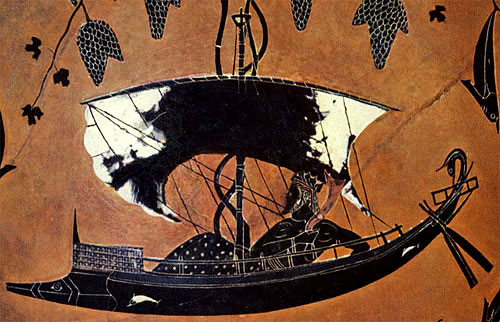
In his introduction to Euripides' Bacchae, E.R. Dodds writes eloquently of the domain of Dionysus:
His domain is, in Plutarch's words, the whole of [liquid nature], not only the liquid fire in the grape, but the sap thrusting in a young tree, the blood pounding in the veins of a young animal, all the mysterious and uncontrollable tides that ebb and flow in the life of nature.
In these "mysterious and uncontrollable tides," of blood and sap and jism and tale and song, flow the god and the goddess endlessly coupling through imagination and nature. This is really what Pound means by Eleusis. In "Canto II," Pound writes a version of the old myth of how when the young Dionysus was in a ship in passage to Naxos, the sailors attempted to kidnap and sell him into slavery. This myth encapsulates the timeless battle between avarice or usura and Eleusis. The boy-god saves himself by turning the greedy crew into dolphins.
In reference to this Canto, William Cookson writes in A Guide to the Cantos of Ezra Pound:
This conflict between the splendour of the universe ... and those who exploit it for the sake of money-lust is at the core of The Cantos.

And this really typifies the difference between the two "conspiracies" that Pound identifies. One flows and one attempts to divert this flow for its own gain. This perhaps explains why the two are so scrambled. It is sometimes hard to distinguish a flow from a block to the flow.
Pound thought that this difference was essentially economic. The first is productive, procreative and creative and the second was usurious -- attempting to generate wealth without production. We only need to look at how much of the current global economy that is based on speculation to realize that the situation has only become more imbalanced since Pound's era.
Yeats summarized the basic division differently. In a December 1920 letter to Lady Gregory, he wrote:
...it is nationalism against internationalism, the rooted against the rootless people.
This is also interesting. Banking, the Empire, the engines of war, the 0.01% are certainly international. Usura really does not care what land it lays waste to, what people it starves or enslaves, as long as it increases itself. The centre of financial and political power continually shifts throughout history. No roots hold it in place.

But, at the same time, Eleusis also flows and grows. It is nomadic, metamorphic, bohemian. It also appears to be without roots. Yeats himself was international in this way. So was Pound and Joyce and most of the figures mentioned in this piece. Definitely their imaginations were not confined by provincial or national borders.
Both the international elite and the international bohemians have a disdain for the settled mundanity of bourgeois morality and existence. Both "conspiracies" are elitist, not democratic, in this regard. They are bitter enemies and yet they share certain convictions.
A bohemian may be a democratic revolutionary (like Blake) or an elitist reactionary (like Pound). They may ally themselves with the elites against the mindless conformity of the middle classes (the "sheep") or they may rise up with the downtrodden and perennial misfits against the Masters of the World.
They are often used by Power -- for ideas, artistic creations, movements, etc. -- but they are notoriously unreliable. Pound at once praises Cosimo de Medici for being a patron of the arts and Hermetic learning, and condemns the Medici family for being the first modern bankers.
Conspiracy theory itself, both terrifying and obsessing the middle classes, is often generated by bohemian crackpots and ne'er-do-wells, but much of it may also be traced back to the elite. The minds of the "rooted" are under constant attack by at least two "rootless" tribes. The "Jews" are opposed to the "Gypsies" and both aim to subvert and violate the "good Germans" or "good Americans." And meanwhile all of these categories are fictions created by the fetid imagination of some self-marginalized crank.

Pound seems to be suggesting something that is quite different than Yeats's distinction, and yet these two may at heart be quite similar. Eleusis, which is not at all synonymous with the bohemian counterculture, is rooted in a profound sense. It is the expression of the divine Light, which is permanent or eternal in both the Neo-Platonism and Chinese philosophy that Pound followed. Usura, on the other hand, obsesses itself only with the discarded forms and husks that this Light flowed through.
The proponents of usura, therefore, are rootless most essentially in their attachment to what is impermanent and transitory. Their power rests in their ability to convince others that material wealth contains intrinsic value. This is the core of the con of usura. It can only attempt to defile, obscure or counterfeit the Light. Eleusis, in contrast, does not seek immortality or other simulacra of permanence. The only thing eternal is the flow and its beauty is only appreciated in its transitory nature. Death is not feared because life, though never staying the same, also never ends.
Letting the Wind Speak
The 1960s, then, were a very mixed bag. Of course the movements that manifested at that time were subjected to the machinations of usura. But, as anyone knows who has listened to the music or has somehow touched the spirit of this decade, something else was happening as well. The general countercultural drift was away from avarice, war and control -- away from usura. Different values, at least nominally, became widespread.
These values -- anti-materialism, creativity, free love, communalism, autonomy, vision -- are antithetical to the desire for material accumulation. They can all be twisted to sell products, but eventually the scam wears thin. It fails to convince and the spell of usura is directly threatened. Psychedelics, while certainly agents of confusion and disorder, undoubtedly can also help to temporarily break the spell. Eleusis, when it is truly seen, is nothing like mind control.
![[ba_summer20_06.jpg]](https://blogger.googleusercontent.com/img/b/R29vZ2xl/AVvXsEiCxQvaD2oF4sRso4dOiVRKFqJWcm2gmiuUceOhuYDnAD32RJTdn4FwCHXXtAfLqS7GixknZHAbaVLMDvhDLoZ2UdWKekUa4Ep5nSFkJzDTp8cMUx9ywgnyY9xBQYl6N-12Yj7DvWbwuCao/s1600/ba_summer20_06.jpg)
The two are like opposite poles of a sphere, two extremes of a spectrum. Usura, being the more solidified and objectified of the two, is more like a conspiracy in the conventional sense (with conspiracy theory providing its myth of omnipotence). Eleusis is revealed in a more or less conscious resonance within art and poetry, and on rare occasions with the artists and poets themselves.
Both are ages old. I've suggested before that both "conspiracies" emerged within the shamanism of hunter-gatherer tribes. The complex of "dark shamanism" (which I was turned on to by Jan Irvin's podcast) may be where the chains of debt can ultimately be traced. And yet both continue today. Both have been active behind the scenes in the formative 108-year period from 1904 to 2012. The inhalation to the present exhalation. Conspiracy and inspiracy. Both usura and Eleusis craft the visible rhythms of history.

These are Ezra Pound's terms, but they really have little to do with his own errors and obsessions. Pound's actual vision is no more "fascist" or "totalitarian" than the great visions of Dante or William Blake. These poets were seers. And as Blake taught, one should not mistake a poet's "Spectre" for the true self which sees. It also has nothing to do with Pound's anti-Semitism. Those that are attracted to this element in his work while ignoring or discarding Eleusis are missing the only thing in it of real value, as Pound himself finally and fully acknowledged.
That I lost my center
fighting the world
This he confessed in "Canto CXVII." And in the next and final Canto:
I have tried to write Paradise
Do not move
Let the wind speak
that is paradise
Let the Gods forgive what I
have made
Let those I love try to forgive
what I have made.

Fighting the world is dangerous. This epic struggle reminds me of the quote by the Dionysian anti-anti-Semite, Friedrich Nietzsche, in Beyond Good and Evil:
Whoever fights monsters should see to it that in the process he does not become a monster. And when you look into the abyss, the abyss also looks into you.
It is easy to take many wrong turns in the search for the infinite. Losing one's centre is almost a part of the plan. Let us take care to not become monsters again.
